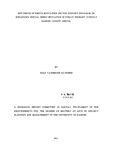| dc.description.abstract | Special education has for the longest time been provided in special schools, more recently in special units attached to regular schools, and most recently through inclusive settings in regular schools. Through KESSP the government initiated efforts aimed at addressing challenges relating to access, equity and quality in the provision of education and training to children with special needs. This was to be achieved through provision of appropriate Adequate Facilities, adequate facilities and equipment, which make it possible to integrate special educatiorf in regular programmes. Additionally through sensitisation of parent and communities as a whole, to support and advocate the enrolment of children with special needs in schools. According to KESSP the target Gross Enrolment Rate (GER) was targeted to rise from 1.4% in 2005 to 10% in 2010 with the percentage of girls enrolled to increase from 0.6% to 5% and the percentage of boys to increase from 0.8% to 5%. In addition, build capacity among teachers to handle children with special needs. Further the program was to achieve appropriate placement of children with disabilities and provide teaching and learning materials.
The objective of this study was to determine the effect of Kenya Education Sector Support program (KESSP) on expanding special needs education through a descriptive research survey of public primary schools in Nairobi East constituencies of Starehe, Kamukunji and Makadara. Cluster sampling techniques was employed to select schools and in turn headteachers. Classroom teachers were be selected through snowballing. Data was collected using selfadministered questionnaires for classroom teachers and interview schedules for headteachers. Descriptive statistics was used predominantly to describe the characteristics of the sample. Data was presented in the form of tables and charts. The study found out that enrolment increased, more schools were able to provide SNE and teacher skills were upgraded. The study concludes' that KESSP succeeded in improving the skills of teachers, provide a framework for sensitization and pupil placement towards SNE expansion despite pupils transition challenges and societal attitudes. Facility provision and improvement was however not adequate to support expansion. Another shortcoming noted was that despite the effort, KESSP was not able to mainstream inclusive SNE. The study recommends SNE policy be develop to guide on education transition, modes of conduct and roles of different stakeholders and reinforce the mainstreaming of inclusion SNE. In future studies should be conducted to evaluate support programs implemented in other sectors and their effects
on various human challenges. | en_US |

